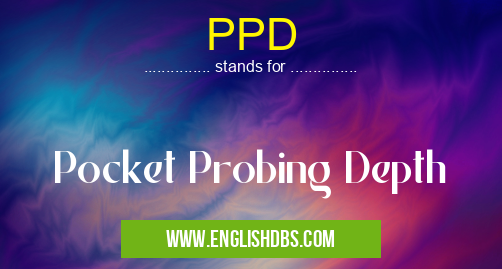What does PPD mean in UNCLASSIFIED
Pocket Probing Depth (PPD) is a measure of the penetration depth of a dental probe in millimeters (mm). It is widely used to assess and diagnose periodontal conditions, with the aim of achieving superior oral health. PPD helps dental professionals and hygienists determine whether there are any areas where gum disease may be present. This metric measures the distance between the bottom of a healthy pocket and an infectious lesion or area that could potentially become infected. It is important to note that measurements made in other parts of the mouth may differ from those taken in the deepest pockets.

PPD meaning in Unclassified in Miscellaneous
PPD mostly used in an acronym Unclassified in Category Miscellaneous that means Pocket Probing Depth
Shorthand: PPD,
Full Form: Pocket Probing Depth
For more information of "Pocket Probing Depth", see the section below.
Definition
The Pocket Probing Depth (PPD) provides information about how far below the surface of the gums a dental probe can penetrate before it hits any signs of infection or inflammation. A normal tissue response should measure at 2-3 mm, while anything higher indicates a potential periodontal condition or problem which needs further investigation and care.
Clinical Significance
Pocket Probing Depths (PPDs) play an important role in diagnosing and managing periodontitis due to their ability to detect changes in pocket depth that don’t show up on radiographs or through physical examination alone. By measuring PPDs, clinicians can identify early signs of progression which allows them to initiate appropriate treatment sooner than they would if they relied solely on radiographic findings. PPD measurements also allow for better comparison between visits so clinicians can monitor the progress of their patients over time and compare current results with prior ones more accurately.
Essential Questions and Answers on Pocket Probing Depth in "MISCELLANEOUS»UNFILED"
What is Pocket Probing Depth?
Pocket Probing Depth (PPD) is a measuring tool used in dentistry to measure the depth of gingival pockets. It is used to assess periodontal disease and check for inflammation.
How does Pocket Probing Depth work?
Pocket Probing Depth works by using a probe which is inserted into the pocket between the gum and the tooth. The depth of the pocket is then measured in millimeters.
Why use Pocket Probing Depth?
Pocket Probing Depth is one of the best ways to accurately measure the severity of periodontal disease and monitor its progress over time as it provides a more quantitative assessment than clinical observation alone.
What can Pocket Probing Depth tell me about my periodontal health?
Pocket probing depth can provide an indication of whether you have healthy gums or if further treatment may be needed. High readings suggest that there may be inflammation present, whereas lower readings would suggest that your gum health is good.
How often should I get a Pocket Probing Depth measurement?
It is recommended that you get your PPD measurement done at least once a year, but depending on your situation, your dentist may recommend more frequent measurements such as every 6 months or even more often if you have severe inflammation or are at high risk for periodontal disease.
Can I get a Pocket Probing Depth measurement at home?
No, this type of measurement cannot be performed at home as it requires special training and equipment which can only be found in dental offices.
Is there any pain associated with having my pocket probing depth checked?
Generally not - most people don't feel any discomfort during their measurement as it only involves lightly inserting a probe into their gums. Your dentist may offer local anaesthetic if they feel that it’s necessary though.
Are there any risks associated with having my pocket probing depth checked?
There are no known risks associated with PPD measurements as long as they are performed by a qualified professional who follows proper sterilisation protocols before each use.
Are there any alternatives to pocket probing depth measurements?
Although not considered an alternative, X-rays can also help diagnose periodontal disease by providing additional information on bone loss around teeth due to infection and gum recession due to inflammation. Some other methods include laser scanning and acoustic analysis which provide further insight into what’s happening beneath the surface of your mouth.
Final Words:
In summary, Pocket Probing Depth (PPD) is a valuable tool for assessing periodontal health and detecting early signs of infection or complications. It offers invaluable insight into areas not visible through simple physical examination or imaging techniques, helping dentists and hygienists recommend treatments that are tailored to each individual patient's needs more accurately.
PPD also stands for: |
|
| All stands for PPD |
